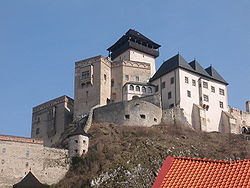
Trencín Castle
Encyclopedia

Trencín
Trenčín is a city in western Slovakia of the central Váh River valley near the Czech border, around from Bratislava. It has a population of more than 56,000, which makes it the ninth largest municipality of the country and is the seat of the Trenčín Region and the Trenčín District...
in western Slovakia
Slovakia
The Slovak Republic is a landlocked state in Central Europe. It has a population of over five million and an area of about . Slovakia is bordered by the Czech Republic and Austria to the west, Poland to the north, Ukraine to the east and Hungary to the south...
.
History
History of the castle goes back to the age of the Roman EmpireRoman Empire
The Roman Empire was the post-Republican period of the ancient Roman civilization, characterised by an autocratic form of government and large territorial holdings in Europe and around the Mediterranean....
, testified by the inscription telling about the victory of the II. Roman legion at Laugaricio (the Latin name of Trenčín) in 179
179
Year 179 was a common year starting on Thursday of the Julian calendar. At the time, it was known as the Year of the Consulship of Aurelius and Veru...
AD. The oldest building is a stone rotunda
Rotunda (architecture)
A rotunda is any building with a circular ground plan, sometimes covered by a dome. It can also refer to a round room within a building . The Pantheon in Rome is a famous rotunda. A Band Rotunda is a circular bandstand, usually with a dome...
, plausibly founded in the Great Moravia
Great Moravia
Great Moravia was a Slavic state that existed in Central Europe and lasted for nearly seventy years in the 9th century whose creators were the ancestors of the Czechs and Slovaks. It was a vassal state of the Germanic Frankish kingdom and paid an annual tribute to it. There is some controversy as...
n period. In the midst of 13th century the castle was the seat of the Baron Jakab Cseszneky
Jakab Cseszneky
Jakab Cseszneky de Csesznek et Visk was a Hungarian aristocrat and first Lord of Csesznek in 13th century.Jakab was the son of Mihály, member of the clan Bána, and equerry of Andrew II of Hungary....
, who was King Béla IV's swordbearer
Swordbearer
Swordbearer is a fantasy role-playing game. It was originally published by Heritage Games in 1982, and then republished by Fantasy Games Unlimited in 1985. The game was written by B. Dennis Sustare with contributions from Arnold Hendrick. Illustrations are by Dennis Loubet and David Helber...
. Later in the 13-14th century, the castle became the residence of Matthew Csák, the legendary "Lord of the river Váh
Váh
The Váh is the longest river in entire Slovakia. A left tributary of the Danube river, the Váh is 406 km long, including its Čierny Váh branch...
and the Tatra Mountains
Tatra Mountains
The Tatra Mountains, Tatras or Tatra , are a mountain range which forms a natural border between Slovakia and Poland, and are the highest mountain range in the Carpathian Mountains...
". He gave name to the Matúš Tower, a keep
Keep
A keep is a type of fortified tower built within castles during the Middle Ages by European nobility. Scholars have debated the scope of the word keep, but usually consider it to refer to large towers in castles that were fortified residences, used as a refuge of last resort should the rest of the...
dominating both the castle silhouette as well as that of the town. The water well is connected to the legend of the Turkish
Ottoman Empire
The Ottoman EmpireIt was usually referred to as the "Ottoman Empire", the "Turkish Empire", the "Ottoman Caliphate" or more commonly "Turkey" by its contemporaries...
prince Omar and his great love for the beautiful Fatima, whom he had to redeem by digging a well in the rock.
Present

External links
Sources
- Györffy György: Az Árpád-kori Magyarország történeti földrajza

